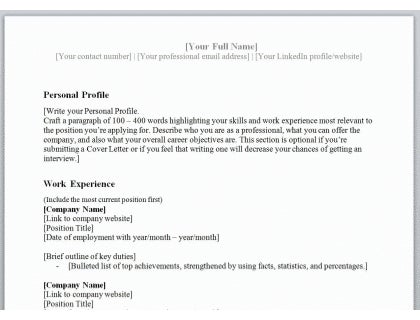
Chronological CV Template in MS Word Format:
Start applying for jobs today using our Chronological CV Template.
Download TemplateHow to Write a CV:

Writing a CV for the first time can be a daunting experience. Which CV layout do you choose? Should you use a template, a CV builder, hire a professional, or write the CV yourself?
There are advantages and disadvantages to each of these options. Below, we list the key steps you need to follow in order to build a professional and effective CV.
Start preparations.
Decide which type of CV format suits you.

Depending on your skills, experience, the stage of your career, and the purpose of your CV, you can select one of the 3 different types of CVs available:
Once you have chosen the most suitable option, you can use one of our templates to help you write your CV. There are also optional sections that can be added depending on the field you are entering or the requirements for a particular position.
There are three main types of CVs listed above. Click on each CV to read our detailed guide and access our free CV templates in MS Word format.
Research the essential sections of a CV.

Whether you're applying for a job, volunteer position, scholarship, research grant, or graduate program, a CV has a few compulsory sections that must be completed. If you leave any of the following information off, your CV will be seen as incomplete.
- Your contact details.
- Work experience.
- Academic qualifications.
- Skills.
The Personal Profile or Personal Statement is regarded as quite useful, but it's not an essential part of your CV. Should you opt to write one, it will fit just below your contact details.
Tailor your CV to suit the job description.

Before preparing your CV, make sure you've understood all the job posting's requirements so that you can tailor your CV to the job you're applying to. It's vital to create a CV that highlights your most relevant skills, qualifications, work experiences, awards, and other important attributes to the hiring manager.
Add your contact details.
Focus on your current contact details.

Your name and contact details are the first things your employer will see listed on your CV. These details should go in the header of your CV to avoid wasting valuable space. Remember to include a professional email address and make sure that all contact numbers are up to date. It is advisable to bold your name and to use a larger font for it.
Example of contact details in the header of a CV:
Julia Charles
julia01.charles@gmail.com
07538 123 678
Do not include your physical address.

In the past, when applications used to be sent via post, your address was a necessary part of the CV. This is no longer the case. In fact, including your address on your CV could compromise your security. Your prospective employer does not require your address at this stage of the recruitment process; it is advisable to leave it out.
Craft a great Personal Profile.
Determine if you require a Personal Profile.

A Personal Profile is the 100 - 450-word paragraph that provides the recruiter with an overview of your skills and experience, and also gives them a glimpse of your potential. It adds a personal touch to your CV and allows you to highlight important aspects of your career.
However, seeing as it's an optional element of your CV, there are some things you need to consider before writing one. Applicants can choose to leave off the Personal Profile if they're submitting a cover letter alongside their application or if they feel writing one is not required for their industry.
Draw attention to the most relevant aspects of your career.

It's a good idea to think of your Personal Profile as a shortened cover letter. This short paragraph atop your CV will be the first thing the hiring manager reads, so make it count, and remember to write a new one for each job application.
It is advisable to write your Personal Profile after you've completed the rest of your CV so that you already have all the important career details laid out for you. Depending on your level of experience, your Personal Profile may include different information compared to those of other candidates.
Consider the following when writing a Personal Profile:
- Experienced Professionals: If you're someone with extensive experience and industry skills, you'll want to use your Personal Profile to draw attention to the most relevant aspects of your career. Mentioning awards and highlighting your value by quoting statistics is a good way to go.
- Students or Inexperienced Graduates: If you're still studying or you're a new graduate who's only ever done volunteer work, you may feel stumped when it comes to writing a Personal Statement. However, you can use this paragraph to mention the skills you've developed during your studies or through the part-time/volunteer work you've done. If you've never done any work outside of college or university, you can outline your career goals to help the hiring manager gauge your potential.
Use the first sentence to describe who you are as a professional.

You may use the first or third person in the paragraph. If you're unsure which one to use, write it both ways and select the best option.
Describe what you can offer the company or institution.

Re-read the job description and also research their current projects or initiatives to identify areas that could be improved upon. Skim your CV and make a note of the most important skills and work experience relevant to your current application.
Do not excessively use jargon or buzzwords.

Be as concise as possible, only listing aspects of your career the hiring manager would be interested in. Where possible, back up your strengths with statistics or facts.
Highlight your career goals.

In the last sentence of your Personal Profile, highlight your career objectives. If you lack work experience, this section might be longer than one sentence. Always be honest, and make sure you proofread your Personal Profile afterward.
Add your work experience.
Highlight all relevant work experience.

Experienced candidates will list their work history above education on their CV. A hiring manager will gain a better understanding of your strengths and soft skills by looking through the section. The type of work you've done, the stage of your career, as well as the job you're applying to, will determine the length of this section.
CVs of those with limited or no work experience will list skills and qualifications first. However, remember that part-time positions, volunteer work, and internships should be included in this section.
When writing your work experience section, remember:
- Always list positions in reverse-chronological order, starting with the most recently held positions first.
- Don't try to hide gaps in employment. Always include the month and the year you started and ended each position.
- You can list between 4 and 6 jobs that are relevant to the position, and only include positions you've held within the last 10 - 15 years.
What to include when listing work experience on a CV:
- The name of the company or institution.
- A link to the website of the company or institution.
- The position you held.
- The precise start and end dates you held that position.
- A brief outline of your key duties.
- The top achievements for each position, strengthened by including facts and percentages/statistics where possible.
Showcase your career milestones.

Instead of listing responsibilities for each position, focus on what you've achieved in each role. If you received an award at your previous job, mention it. Think about the difference you made at your last place of work. If you can include percentages and statistics they will strengthen your claims.
Add a education and training section.
Include your academic qualifications.

This is sometimes called the Education and Training section and all your important qualifications are listed here. If you continued your studies after high school, list only your tertiary education here. However, if you've achieved multiple degrees or diplomas, list the most recent or the most relevant. Be sure to mention any awards or honors.
Include the dates of your qualification.

Applicants who lack work experience may have a more detailed Education and Training section than those who have been formally employed. New graduates may want to include the date each qualification was obtained, but this is not a strict requirement, especially if your Work Experience section is more prominent.
Add your skills.
Include 5 - 10 relevant skills.

It's important to be selective in the skills section of your CV. Limit this section to between 5 and 10 skills that are relevant to the position you're applying to. Do not mention skills for outdated or old software. This section typically takes the form of a short bulleted list, but if you choose the Functional CV, it will be an extensive section right below your Personal Profile.
Only list things that are actually skills.

Don't list old or outdated skills or skills the hiring manager would expect you to have, like being able to send an email. In addition, do not confuse skills with hobbies or occasional work. For example, you cannot list 'Human Resource Planning' under skills because you've assisted the HR Manager once or twice.
List both hard and soft skills.

Hard skills refer to specific skills that can be taught and measured, like any degree, diploma, or certificate. Soft skills are individual personality traits or attributes that are often learned through everyday experience, for example, motivational skills or emotional intelligence.
List soft skills you can provide evidence for in your cover letter or personal profile, for example, if you list leadership skills, then you'll want to provide proof of how well you lead your team, e.g. 'Improved overall team productivity by 40% in the space of two years.
Do not lie or embellish.

Lying and exaggerating about your abilities on your CV is not advisable. Focus instead on your strengths. If you're struggling to decide which skills to include on your CV, examine the job posting again or read through our comprehensive list of job descriptions to get inspired.
Cover Letter Examples:
Personal Profile:
Example of a Personal Profile for an Experienced Professional:
I am a highly-skilled English Teacher eager to join a grammar school. I have taught at four different schools and trained students to compete in several national competitions. My greatest strengths are my passion for language and my desire to help students understand it. St Olave's innovative language department is the perfect place for me to grow.
What makes the above paragraph effective?
- It's concise.
- The candidate introduces herself without overusing buzzwords or jargon.
- No statistics are included, but she does offer proof of her skills by mentioning she's trained students for competitions.
- Her two biggest strengths are summed up in one sentence.
- The final selling point mentions the school by name, indicating that the Personal Statement and CV have been tailored to this job application. Without going into detail, she hints that she's done her research on the school and learned that they have a progressive language department that's a great place for her to expand her knowledge and skillset.
Example of a Personal Profile for a Student or Inexperienced Graduate:
I am a recent Engineering graduate from Newcastle University and I am keen to gain more practical experience at wastewater treatment plants. In my final year, I scored a distinction for my project on how membrane technology is used in wastewater treatment. I have learned to work alone and to collaborate with other researchers and technicians. Working alongside the experts at British Water would be a privilege.
What makes the above paragraph so effective?
- It's concise.
- In the first sentence, the candidate introduces himself, mentions his link to a prestigious university, and also points out that he's had some kind of practical experience in his area of specialization.
- The second sentence is used to highlight an achievement, providing evidence of the candidate's skill regardless of his lack of formal work experience.
- The candidate does resort to buzzwords like 'leadership skills' or 'team player', but he mentions the professionals he has collaborated with and also points out that he can work unsupervised.
- The candidate closes by mentioning the Group, British Water, by name and also referring to its employees as 'experts', which drives home the idea that he holds the group in high regard.
Work Experience:
Example of how to list work experience on a CV:
DEF Project Management
www.defprojectmanagement.co.uk
Operations Manager
January 2010 - December 2015
Worked alongside senior stakeholders to design, implement, and improve existing policies and procedures. Managed 4 different teams at DEF Project Management.
- Recruited new talent that improved the overall performance of each team by between 40% and 50%.
- Cut overall budget costs by 30%.
- Won Best Manager Award for two consecutive years.
What makes the above work experience entry effective?
- All the essential elements, like the name of the company, their website link, the job title and duration of the job, as well as the key duties and achievements are included.
- There's a brief overview of the main duties.
- Three key achievements are mentioned and percentages, as well as facts, are provided to strengthen these achievements.
Depending on your experience and the relevance of each position you've held, try to include at least 3 jobs under the Work Experience section, but you can add more provided they have been held within the last 15 years.
Academic Qualifications:
Example of how a recent graduate might list their Qualifications:
MA Creative Writing
Newcastle University
United Kingdom
2020 - 2022
- Completed a 2-year MA programme, specializing in Narrative Journalism and Short Stories.
- Received a scholarship to complete 6 months at Columbia University.
- Position on the Dean's Honours List.
- Passed Summa Cum Laude.
Example of how an experienced professional might list their Qualifications:
MA Creative Writing, Newcastle University, United Kingdom.
Note how the date the degree was obtained is not entered in the qualifications section of the experienced professional.
Skills:
Example of how to list your skills:
Skills:
- Proficiency with CAD and AutoCAD software.
- Manual drafting skills.
- Analytical skills.
- Critical thinking.
- Project management.
- Leadership.
- Collaboration.
- Customer service.
What makes the above skill list effective?
- Hard skills pertaining to the specific job are listed first, and particular software is mentioned.
- Soft skills that follow can be backed up by evidence in the candidate's Cover Letter, Personal Profile, or their online portfolio.
- Generic skills like communication and multitasking are not included.
Additional Sections of your CV:
The CV is fundamentally different from the Resume because of the additional sections. The maximum length of a standard resume should be 2-pages, but a CV increases as your experience, qualifications, skills, awards, and published works do. See more on CVs vs resumes.
Listed below are the additional sections you can add to your CV:
- Books or chapters you've written.
- Journal articles.
- Peer-reviewed articles.
- Other publications.
- Awards, honours, or achievements.
- Additional certifications and licenses.
- Fellowships, grants, and scholarships.
- Conferences attended.
- Presentations or lectures delivered.
- Teaching experience.
- Nonacademic activities, like relevant or notable interests/hobbies.
- Graduate fieldwork.
- Research or lab experience.
- Additional languages.
- Memberships.
- Volunteer work/initiatives.
- Projects.
- References.
Be sure that the additional sections of your CV follow in logical order after your essential sections.
What if my CV is not for a job application?
Not all CVs are submitted by job seekers. You may also need a CV when you apply for volunteer work or to gain admission to a university graduate programme. Be sure to read the application guidelines thoroughly and to tailor your CV according to their requirements. You may also need to write a Motivation Letter. You can find helpful guidelines, tips, and a useful template in our article on How to Write a Cover Letter.
Ensure your CV complements your cover letter.
The Cover Letter you include with you application is really important, especially if you're submitting an extensive CV. The Hiring Manager may read the Cover Letter long before they even look at your CV, so make a good impression. Use your Cover Letter to elaborate on your most important skills, experience, and attributes mentioned in your CV.
Do not summarize your CV in the Cover Letter. Follow our guide to help you craft an excellent Cover Letter.
Additional Resources:
Study this list of action verbs for resumes to prepare for writing.

